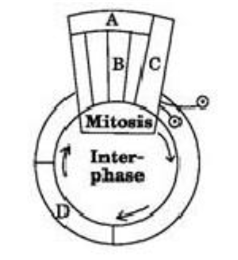 Multiple Choice Questions
Multiple Choice QuestionsPlasmodesmata are
lignified cemented layers between cells
locomotory structures
membranes connecting the nucleus with the plasmalemma
membranes connecting the nucleus with the plasmalemma
Cytoskeleton is made up of
calcium carbonate granules
callose deposits
cellulosic microfibrils
cellulosic microfibrils
Given below is a schematic break-up of the phase/stages of cell cycle
Which one of the following is the correct indication of the stage/phase in the cell cycle?
B -Metaphase
C-karyokinesis
D-Synthetic phase
D-Synthetic phase
Vacuole in a plant cell
is membrane-bound and contains storage
is membrane-bound and contains water and excretory substances
lacks membrane and contains air
lacks membrane and contains air
The length of DNA molecule greatly exceeds the dimensions of the nucleus in eukaryotic cells. How is this DNA accommodated?
Deletion of non-essential genes
Super-coiling in nucelosomes
DNAse digestion
DNAse digestion
Which one of the following is not a constituent of cell membrane?
Cholesterol
Glycolipids
Proline
Proline
During the transmission of nerve impulse through a nerve fibre, the potential on the inner side of the plasma membrane has which type of electric change?
First negative, then positive and again back to negative.
First positive, then negative and continue to be negative
First negative, then positive and continue to be positive
First negative, then positive and continue to be positive
Select the wrong statement from the following:
Both chloroplasts and mitochondria contain an inner and an outer membrane
Both chloroplasts and mitochondria have an internal compartment, the thylakoid space bounded by teh thylakoid membrane
Both chloroplasts and mitochondria contain DNA
Both chloroplasts and mitochondria contain DNA
If you are asked to classify the various algae into distinct groups, which of the following characters you should choose?
types of pigments present in the cell
nature of stored food materials in the cell
structural organization of thallus
structural organization of thallus
A.
types of pigments present in the cell
Type of pigments present in the cell of algae is the most important character for classification.
A major breakthrough in the studies of cells came with the development of electron microscope. This is because
the resolution power of the electron microscope is much higher than that of the light microscope
the resolving power of the electron microscope is 200 – 350 nm as compared to 0.1 – 0.2 nm for the light microscope
electron beam can pass through thick materials, whereas light microscopy requires thin sections
electron beam can pass through thick materials, whereas light microscopy requires thin sections
